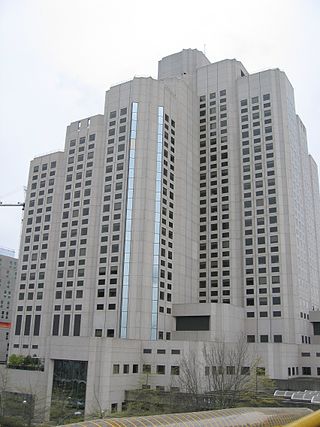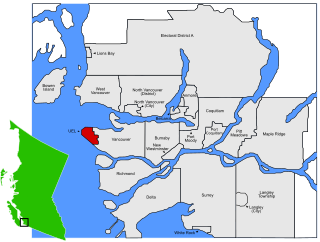
The Downtown Eastside (DTES) is a neighbourhood in Vancouver, British Columbia, Canada. One of the city's oldest neighbourhoods, the DTES is the site of a complex set of social issues, including disproportionately high levels of drug use, homelessness, poverty, crime, mental illness and sex work. It is also known for its strong community resilience, history of social activism, and artistic contributions.

Marpole, originally a Musqueam village named c̓əsnaʔəm, is a mostly residential neighbourhood of 23,832 in 2011, located on the southern edge of the city of Vancouver, British Columbia, immediately northeast of Vancouver International Airport, and is approximately bordered by Angus Drive to the west, 57th Avenue to the north, Ontario Street to the east and the Fraser River to the south. It has undergone many changes in the 20th century, with the influx of traffic and development associated with the construction of the Oak Street Bridge and the Arthur Laing Bridge.

Vancouver General Hospital is a medical facility located in Vancouver, British Columbia. It is the largest facility in the Vancouver Hospital and Health Sciences Centre (VHHSC) group of medical facilities. VGH is Canada's third largest hospital by bed count, after Hamilton General Hospital, and Foothills Medical Centre.

Vancouver Hospital and Health Sciences Centre (VHHSC) is an acute care hospital affiliated with the University of British Columbia and located in Vancouver, British Columbia. The VHHSC is the second largest hospital in Canada, with 1,900 beds and nearly 116,000 patients each year. VHHSC employs 9500 staff and utilizes 1000 volunteers. As of 2005, the hospital's annual budget is $463 million. It is managed by Vancouver Coastal Health.

Rancho Los Amigos National Rehabilitation Center is a rehabilitation hospital located in Downey, California, United States. Its name in Spanish means 'Friends' Ranch'.

Provincial Health Services Authority (PHSA) is a publicly funded health service provider in the province of British Columbia. PHSA is unique in Canada as the only health authority having a province-wide mandate for specialized health services, although within British Columbia the First Nations Health Authority is also non-regional and highly dispersed. The five other health authorities in the province have regional jurisdiction. Services are provided either directly through PHSA agencies or through funding or collaboration with regional health authorities.

B.C. Women's Hospital & Health Centre, an agency of the Provincial Health Services Authority (PHSA), is a Canadian hospital located in Vancouver, British Columbia, Canada, specializing in women's health programs. It is the only facility in Western Canada dedicated to the health of women, newborns and families, and is the largest maternity hospital in the country. It is a teaching hospital and major provincial health care resource, and is a key component in women's health research.

British Columbia Children's Hospital is a medical facility located in Vancouver, British Columbia, and is an agency of the Provincial Health Services Authority. It specializes in health care for patients from birth to 16 years of age. It is also a teaching and research facility for children's medicine. The hospital includes the Sunny Hill Health Centre, which provides specialized services to children and youth with developmental disabilities aged birth to 18 years.
Providence Health Care is a Catholic health care provider that operates seven facilities in Vancouver, British Columbia, Canada.
The Ministry of Health is a department of the Government of British Columbia which oversees the provincial healthcare system. It manages services including the Medical Services Plan, HealthLinkBC, and the PharmaCare program.
GF Strong Rehabilitation Centre is the largest rehabilitation hospital in British Columbia. It is located in the South Cambie neighbourhood of Vancouver.
Richmond Hospital (RH) is a medical facility in Richmond, British Columbia, Canada. The Vancouver Coastal Health Authority (VCH) is responsible for Richmond Health Services and Richmond Hospital.

Riverview Hospital was a Canadian mental health facility located in Coquitlam, British Columbia. It operated under the governance of BC Mental Health & Addiction Services until it closed, in July 2012. In December 2015, the provincial government announced plans to replace the obsolete buildings with new mental health facilities, scheduled to open in about 2019. On October 12, 2021, the new Red Fish Healing Centre for Mental Health and Addiction opened on the site.

Pukeora Sanatorium or Pukeora Tuberculosis Sanatorium was a tuberculosis (TB) hospital in the Hawke's Bay, New Zealand.

St. Paul's Hospital is an acute care hospital located in downtown Vancouver, British Columbia, Canada. It is the oldest of the seven health care facilities operated by Providence Health Care, a Roman Catholic faith-based care provider. St. Paul's is open to patients regardless of their faith and is home to many medical and surgical programs, including cardiac services and kidney care including an advanced structural heart disease program and North America's largest Addiction Fellowship program. It is also the home of the Pacific Adult Congenital Heart Disease unit. It is one of the teaching hospitals of the University of British Columbia Faculty of Medicine. Approximately 4000 people work at St Paul's Hospital.
Marpole Women's Auxiliary is a charity in Vancouver, British Columbia that supports residents at George Pearson Centre and G. F. Strong Centre. It was established in 1938 to support The Marpole Infirmary, located in an area of Vancouver referred to as Marpole.

Royal Columbian Hospital (RCH) is among the oldest hospitals in British Columbia and one of the busiest in the Fraser Health Authority. It is located in New Westminster overlooking the Fraser River and is the only hospital in the Lower Mainland that is immediately adjacent to a Skytrain station (Sapperton).

The University Endowment Lands (UEL) is an unincorporated area that lies to the west of the city of Vancouver, British Columbia, Canada, and adjacent to the University of British Columbia (UBC) and the lands associated with that campus. Pacific Spirit Regional Park lies within the UEL. The UEL is part of Metro Vancouver. Mail sent to the UEL is addressed to "Vancouver" rather than the UEL.
George Sharratt Pearson was a Canadian politician in the province of British Columbia. He represented the ridings of Nanaimo from 1928 to 1933, Alberni-Nanaimo from 1933 to 1941 and Nanaimo and the Islands from 1941 to 1952 in the Legislative Assembly of British Columbia as a Liberal.

Abbotsford Regional Hospital and Cancer Centre (ARHCC) is a 300-bed Canadian health care facility in the City of Abbotsford, British Columbia that houses the acute care Abbotsford Regional Hospital (ARH) operated by Fraser Health and the regional cancer facility operated by the BC Cancer Agency.














